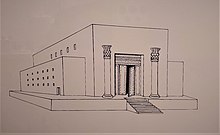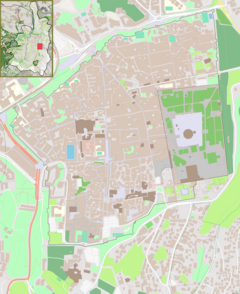| Solomon's Temple First Temple | |
|---|---|
בֵּית-הַמִּקְדָּשׁ הָרִאשׁוֹן | |
 Modern artistic depiction of Solomon's Temple at the Israel Museum | |
| Religion | |
| Affiliation | Yahwism |
| Deity | Yahweh |
| Leadership | High Priest of Israel |
| Location | |
| Location | Temple Mount, Jerusalem |
| Country | Kingdom of Judah (at the time of destruction) |
Location within the Old City of Jerusalem Location within Jerusalem (modern municipal borders) Location within the State of Israel | |
| Geographic coordinates | 31°46′41″N 35°14′07″E / 31.778013°N 35.235367°E |
| Architecture | |
| Founder | Unknown, but attributed to Solomon in the Hebrew Bible |
| Completed | c. 10th–8th century BCE |
| Destroyed | 587 BCE |
Solomon's Temple, also known as the First Temple (Hebrew: בֵּית-הַמִּקְדָּשׁ הָרִאשׁוֹן, romanized: Bēṯ ham-Mīqdāš hā-Rīšōn, lit. 'First House of the Sanctum'), was a biblical Temple in Jerusalem believed to have existed between the 10th and 6th centuries BCE. Its description is largely based on narratives in the Hebrew Bible, in which it was commissioned by biblical king Solomon before being destroyed during the Siege of Jerusalem by Nebuchadnezzar II of the Neo-Babylonian Empire in 587 BCE.[1] No remains of the destroyed temple have ever been found. Most modern scholars agree that the First Temple existed on the Temple Mount in Jerusalem by the time of the Babylonian siege, and there is significant debate among scholars over the date of its construction and the identity of its builder.
The Hebrew Bible, specifically within the Book of Kings, includes a detailed narrative about the construction's ordering by Solomon, the penultimate ruler of the United Kingdom of Israel. It further credits Solomon as the placer of the Ark of the Covenant in the Holy of Holies, a windowless inner sanctum within the structure.[2] Entry into the Holy of Holies was heavily restricted; the High Priest of Israel was the only authority permitted to enter the sanctuary, and only did so on Yom Kippur, carrying the blood of a sacrificial lamb and burning incense.[2] In addition to serving as a religious building for worship, the First Temple also functioned as a place of assembly for the Israelites.[3] The First Temple's destruction and the subsequent Babylonian captivity were both events that were seen as a fulfillment of biblical prophecies and thus affected Judaic religious beliefs, precipitating the Israelites' transition from either polytheism or monolatrism (as seen in Yahwism) to firm Jewish monotheism.[3][original research?]
Previously, many scholars accepted the biblical narrative of the First Temple's construction by Solomon as authentic. During the 1980s, skeptical approaches to the biblical text as well as the archaeological record led some scholars to doubt whether there was any Temple in Jerusalem constructed as early as the 10th century BCE.[4] Some scholars have suggested that the original structure built by Solomon was relatively modest, and was later rebuilt on a larger scale.[5] No direct evidence for the existence of Solomon's Temple has been found.[6][7] Due to the extreme religious and political sensitivity of the site, no recent archaeological excavations have been conducted on the Temple Mount. Nineteenth and early-twentieth century excavations around the Temple Mount did not identify "even a trace" of the complex.[8] The House of Yahweh ostracon, dated to the 6th century BCE, may refer to the First Temple.[9][10] Two 21st century findings from the Israelite period in present-day Israel have been found bearing resemblance to Solomon's Temple as it is described in the Hebrew Bible: a shrine model from the early half of the 10th century BCE in Khirbet Qeiyafa; and the Tel Motza temple, dated to the 9th century BCE and located in the neighbourhood of Motza within West Jerusalem.[11][12] The biblical description of Solomon's Temple has also been observed to share similarities with several Syro-Hittite temples of the same period discovered in modern-day Syria and Turkey, such as those in Ain Dara and Tell Tayinat.[13][14] Following Jewish return from exile, Solomon's Temple was replaced with the Second Temple.[15]
- ^ Temple of Jerusalem: totally destroyed the building in 587/586
- ^ a b Britannica: Holy of Holies.
- ^ a b Temple of Jerusalem.
- ^ Garfinkel & Mumcuoglu 2019, p. 2.
- ^ David Ussishkin In: A.G. Vaughn and A.E. Killebrew (eds.), Solomon's Jerusalem: The Text and the Facts on the Ground. Jerusalem in Bible and Archaeology; The First Temple Period, Atlanta, 2003, pp. 103–115
- ^ Finkelstein & Silberman 2002, p. 128: Moreover, for all their reported wealth and power, neither David nor Solomon is mentioned in a single known Egyptian or Mesopotamian text. And the archaeological evidence in Jerusalem for the famous building projects of Solomon is nonexistent.
- ^ Lundquist 2008, p. 45: The single most important fact regarding the Temple of Solomon is that there are no physical remains of the structure. There is not a single object or artifact that can be indubitably connected with the Temple of Solomon
- ^ Finkelstein & Silberman 2002, p. 128
- ^ Cite error: The named reference
Cambridgewas invoked but never defined (see the help page). - ^ Cite error: The named reference
:2was invoked but never defined (see the help page). - ^ Shapira, David (2018). "The Moza Temple and Solomon's Temple" (PDF). Bibliotheca Orientalis. 75 (1–2): 25–48.
- ^ Garfinkel & Mumcuoglu 2019.
- ^ Batiuk, S., Harrison, T E, and Pavlish, L., The Ta'yinat Survey, 1999-2002, in The Amuq Valley Regional Projects, Volume 1: Surveys in the Plain of Antioch and Orontes Delta, Turkey, 1995–2002, Oriental Institute Publications 131, pp. 171-192, Oriental Institute, 2005
- ^ Monson, John M. "The Temple of Solomon: Heart of Jerusalem", C. The Ain Dara Temple: A New Parallel from Syria, pp. 10, 16. In "Zion, city of our God", Wm. B. Eerdmans Publishing (1999), editors: Hess, Richard S. & Wenham, Gordon J. ISBN 978-0-8028-4426-2. Retrieved 15 February 2011.
- ^ Cite error: The named reference
:5was invoked but never defined (see the help page).


